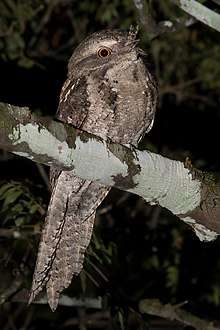Marbled frogmouth
The marbled frogmouth (Podargus ocellatus) is a bird in the family Podargidae. The species was first described by Jean René Constant Quoy and Joseph Paul Gaimard in 1830. It is found in the Aru Islands, New Guinea and Queensland. Its natural habitats are subtropical or tropical moist lowland forest and subtropical or tropical moist montane forest.
| Marbled frogmouth | |
|---|---|
 | |
| In Mount Glorious, Queensland, Australia | |
| Scientific classification | |
| Kingdom: | Animalia |
| Phylum: | Chordata |
| Class: | Aves |
| Order: | Caprimulgiformes |
| Family: | Podargidae |
| Genus: | Podargus |
| Species: | P. ocellatus |
| Binomial name | |
| Podargus ocellatus | |
There are five subspecies recognised; the nominate ocellatus is found in New Guinea and surrounding islands. Two subspecies are found on islands of Papua New Guinea; intermedius is found on Trobriand Islands and D'Entrecasteaux Islands, meeki is endemic to Tagula Island. Australia has two subspecies; marmoratus is found on Cape York Peninsula, plumiferus (known locally as the plumed frogmouth) is found in south-east Queensland.[2][3]
The Conondale ranges in Queensland's Sunshine Coast is considered a stronghold for the plumed frogmouth; notable populations are within the Conondale National Park. The species is rare and is listed as vulnerable in Queensland and occurs in subtropical rainforest and vineforest at altitudes from 50–800 m.[4] The species roosts in the canopy of and is considered cryptic and extremely hard to find or study. Current populations are threatened by land clearing, inappropriate fire regimes and timber harvesting with future impacts of climate change posing additional risks.[5] There have been estimates of the current pairs in the Conondale ranges being around 800 pairs with the current range of the species is just under 2000 ha with some potential future habitat increase in population being created by regenerating rainforest previously logged. Its specialised habitat requirements being un-logged pristine forests, the species is considered extremely vulnerable due to significant habitat reduction.[4] Future harvesting of native timber in the Conondale region also poses risk.[4]
Rigidipenna inexpectatus, endemic to four islands in the Solomon Islands, was formerly considered a subspecies. It was split into its own genus, Rigidipenna, in 2007.[6]
References
- BirdLife International (2013). "Podargus ocellatus". IUCN Red List of Threatened Species. 2013. Retrieved 26 November 2013.CS1 maint: ref=harv (link)
- "Archived copy". Archived from the original on 14 July 2014. Retrieved 16 May 2013.CS1 maint: archived copy as title (link)
- "Archived copy" (PDF). Archived from the original (PDF) on 18 June 2012. Retrieved 16 May 2013.CS1 maint: archived copy as title (link)
- Smith, G.C., Hamley, B.J., Lees, N., 1998. An Estimate of the Plumed Frogmouth Podargus ocellatus plumiferus Population Size in the Conondale Ranges [WWW Document]. URL http://search.informit.com.au/documentSummary;dn=668756953042077;res=IELNZC Archived 16 November 2017 at the Wayback Machine (accessed 4.16.14).
- Smith, G.C., Hamley, B.J., 2009. Variation in vocal response of Plumed Frogmouth (Podargus ocellatus plumiferus) to call-playback. Emu 109, 339–343.
- Cleere et al. 2007. A new genus of frogmouth (Podargidae) from the Solomon Islands – results from a taxonomic review of Podargus ocellatus inexpectatus Hartert 1901. Ibis 149:271-286
